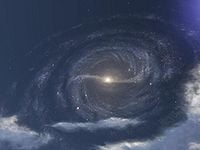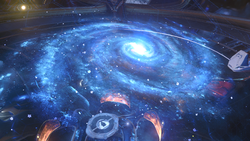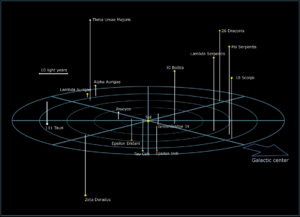Milky Way
From Halopedia, the Halo wiki
| There is more information available on this subject at Milky Way on the English Wikipedia. |

The Milky Way is a barred spiral galaxy approximately 100,000 light years in diameter that lies within the local group of the galactic neighborhood. It is approximately 100,000 light years in diameter and is estimated to contain 100—400 billion stars. The Milky Way is orbited by two small satellite galaxies known as the Magellanic Clouds.[1] It is the galaxy where humanity and the former Covenant client species reside,[2] although their overall influence is limited to only small portions of the Milky Way. The galaxy is also home to a number of other intelligent species, although only a small number of these have attained spacefaring or even technological status.[3]
Description
The Milky Way is a barred spiral galaxy of either SBb or SBc classification on the Hubble Sequence. It has two major arms, each sporting several minor arms that stem off of the major arm. One of these major arms, the Carina and Sagittarius Arm, is home to the Orion Arm. Splotches of intense star birth and formation can be seen in the arms. These areas are pink/red in hue and appear as wisps or clouds situated in the galactic plane. The Milky Way is visible from Earth as a band of light in the night sky, from which its English name derives from.
The Orion Arm
- Main article: Orion Arm
The Orion Arm is the origin of humanity and their home planet Earth, with at least 800 worlds inside human territory at the height of human colonial expansion. It is also the point of origin for several of the Covenant races along with a number of their colony worlds.[3] The Forerunner homeworld Ghibalb, as well as the Orion complex which housed the galaxy-spanning Forerunner ecumene's core worlds, are also located in the Orion Arm.
The Orion Arm was the setting for the Human-Covenant War of the 26th Century and the ancient Forerunner-Flood war, witnessing at least two massive wars. It is also the home of at least two Halo installations and a slipspace portal to the Ark.
Other Galactic components
The Milky Way is composed of a disk, in which all the arms and the majority of galactic matter lies, and the galactic bulge, essentially the center of a galaxy. The bulge is home to the galactic nucleus, the dead center of a galaxy and home to an extremely dense clustering of ancient stars. The nucleus is also thought to support a supermassive black hole. Additionally, most known galaxies possess a halo of old and dying star clusters left over from the galaxy's formation. These clusters are situated up to 100,000 light years from the galactic bulge. Habitable planets may certainly lie within the halo, and some clusters may escape the range of the Halo Effect given their distance from the galactic center.
History
Prehistory
100,000 years before the present day, the previous galactic community was dominated by the Forerunners, a now extinct species that possessed extremely advanced technology and an empire that spanned a significant portion of the galaxy. Millions of years before the rise of the Forerunners, an even more advanced civilization known as the Precursors controlled the Milky Way. Having reached the pinnacle of technological advancement, they were believed to have significantly contributed to the evolution of life across the galaxy, even created several species, such as Forerunners and humans. Over ten million years before the present, however, the Forerunners rose up against their creators in defiance of their decision to bestow their Mantle on humanity,[4] and seemingly ended their rule in the galaxy after destroying their last remnants in the Large Magellanic Cloud.[5]
The Forerunners, originating from Ghibalb in the Orion complex, ruled a large portion of the galaxy for millions of years, affecting the development of other species as they saw fit. Around 150,000 BCE, humanity, still composed of many species, arose from their homeworld Earth, known as "Erde-Tyrene" at the time. They mastered interstellar travel and began to move their civilization along the Orion Arm of the Milky Way. They later allied with the San'Shyuum species, forming a prosperous interstellar empire based on the planet Charum Hakkor. Around 107,445 BCE, humanity and their San'Shyuum allies came into contact with the Flood, a sentient parasite supposedly originating from the Large Magellanic Cloud.[1] Hundreds of systems were lost to the parasite in the resulting conflict. Meanwhile, humanity's aggressive expansion and the perceived violations of the Mantle prompted the Forerunners to take action and begin a war against humanity. Although the Flood later withdrew and seemingly died out from the galaxy, it had already weakened the humans enough to allow the Forerunners to emerge victorious.[6]
Following the war in approximately 106,445 BCE, the Forerunners dismantled humanity's civilization, regressing them into a Tier 7 species. The remaining humans were devolved and exiled to their homeworld, where they slowly began to redevelop a primitive civilization under the tutelage of the Forerunner Lifeshaper, the Librarian.[6]
Activation of the Halo Array
- Main article: Forerunner-Flood war
10,000 years after humanity's conflict with the Flood, the parasite resurfaced and attacked worlds of the Forerunners' domain. Encounters with the Flood led to the Forerunner-Flood war, with the Flood consuming or killing the great majority of the galaxy's sentient species as the Forerunners first studied them, and then tried to stop them. Eventually, the Forerunners were forced to activate the ultimate weapon, the Halo Array, in order to stop them - at the same time, killing its builders. The Forerunners built safe havens, including the Shield Worlds and the Ark, to save the remaining sentient species in plan known as the Conservation Measure, before activating the Array, scouring the galaxy of all sentient life forms and killing the Flood except for samples kept on the Halos, then releasing the saved species from their havens to their home worlds.
Galactic recovery
Almost 100,000 years afterward, the galaxy had recovered substantially, leading to the rise of two great civilizations; the UNSC, comprised of the majority of humanity and controlled from Earth, and the Covenant, a hegemony of many different species who worshiped the Forerunners as gods. Contact between the UNSC and Covenant was not peaceful, leading to the Human-Covenant War, which destroyed hundreds of human colonies and killed billions of colonists and UNSC military personnel, since the Covenant possessed more advanced technology, mostly reverse-engineered from Forerunner artifacts.
The discovery of one of the Forerunners Halo installations set forth a series of events that would not only end the war, but also destroy the Covenant and begin a Covenant civil war, or Great Schism. Triggered by the replacement of the Sangheili with the Jiralhanae in the Covenant military hierarchy, the Sangheili left the Covenant, in the process that consumed a significant amount of the Covenant's populace and resources. A major breakaway faction led by Arbiter Thel 'Vadam, realizing that the Prophets were conducting an unjustified war against humanity and planning a misguided activation of the Halo Array, allied with the UNSC to stop them, leading to the destruction of the Covenant in the Battle of Installation 00.
Post-war
Following the end of the Human-Covenant War, humanity began a long process of rebuilding, while elements within the Office of Naval Intelligence sought to ensure their former enemies - mainly the Sangheili - would not rise again. Meanwhile, humanity gained significant advances in technology due to the discovery of Forerunner artifacts during and after the war.
Though the civilization of the Sangheili had plunged into chaos due to the breaking of the Covenant,[7] the conflict between them and the Jiralhanae would still rage by 2559. Humanity, as well, would continue to face conflict both within and without, in the form of resurgent Insurrectionist movements as well as various hostile Covenant remnants. This irregular conflict was later characterized by significant Forerunner involvement, both in terms of contention for Forerunner artifacts but also the reawakening of the Forerunner commander known as the Ur-Didact and his Promethean armies on Requiem.
Exploration
UNSC
- Main article: Human colonies
The human colonization of space in the modern era began with the colonization of the Solar System during the late 21st and early to mid-22nd centuries. During this time, Luna, Mars, the Jovian Moons and a number of asteroids in the system were colonized by Earth's various national governments, under the direction of the United Nations. During 2160 - 2170, the Solar System was the site of several conflicts, the most prominent being the Interplanetary War, the most brutal conflict known to man since World War II. These conflicts also marked the beginning of the United Nations Space Command.
The development of the Shaw-Fujikawa Translight Engine in 2291 allowed humanity to leave the confines of its home star system for the first time and explore the wider galaxy, ushering in an age of rapid colonization and expansion. The first line of colony ships were unveiled in 2310, and over the next 28 years, the UNSC began terraforming and colonizing more than 210 worlds, which would become the Inner Colonies. Colonial expansion continued and by 2490, UNSC colonial space encompassed over 800 worlds, large and small, in the Orion Arm. The success of colonization of the Outer Colonies made the Inner Colonies the primary stronghold, both military and economic, though they relied heavily on raw materials supplied by the Outer Colonies. At the end of the Golden Age of human expansion in the twilight of the 25th century, tensions between the Inner and Outer colonies culminated in hundreds of civil wars waged across the Outer Colonies, collectively termed as the Insurrection.
In 2525, humanity made contact with the genocidal alien hegemony known as the Covenant, bent on humanity's destruction. During the 27 years of conflict, hundreds of human colonies were destroyed and billions of civilians and military personnel were killed by the Covenant.
Covenant
- Main article: Covenant

Because the Covenant have been spacefaring for over two millennia,[8] and possess far superior slipstream navigation technology to humanity, they have explored a significantly larger portion of the galaxy than humanity has. Based primarily in the Orion Arm of the Milky Way, it is unknown if they maintain territories outside of the region, but there are several homeworlds and colonies located in the Orion Arm. Additionally, the Covenant have discovered and explored several Forerunner shield worlds as well as other Forerunner artifacts, from which they have acquired much of their advanced technology.
The Human-Covenant War has devastated numerous human worlds, but at least one Covenant world, Joyous Exultation, was devastated by Admiral Whitcomb's NOVA bomb in retribution for the destruction of Reach. It is unknown if the Brute- and Sangheili-led Covenant destroyed worlds under the control of the other faction during the Great Schism, but both Te and Balaho, the Lekgolo and Unggoy homeworlds respectively, were almost glassed during the Covenant's history.
Forerunner
- Main article: Forerunner
The Forerunners, having been spacefaring for millions of years and possessing slipspace technology allowing them to cross galactic distances in a negligible time, had explored significant portions of the galaxy. Their ecumene encompassed three million fertile worlds,[9] along with many artificial installations they had constructed. The Forerunners divided the galaxy into margin arcs and themas, with the latter being defined by galactic-scale magnetic fields.[10] They were also capable of traveling outside the galaxy, including an expedition to the Large Magellanic Cloud and the construction of the Arks hundreds of thousands of lightyears from the galaxy.[11]
Locations
Orion Arm
- Main article: Orion Arm
The Milky Way, and the Orion Arm in particular, has a large number of inhabited or, at least, habitable, planets within it, with the Unified Earth Government and the Covenant both maintaining distinct territories of their own. Other planets and systems were once home to the ancient Forerunners, whose interstellar empire spanned the galaxy until their disappearance, as well as the contemporary empires of other species, including humanity and the San'Shyuum.
- Human systems and worlds (prehistoric humans)
- Covenant systems and worlds
- Forerunner systems and worlds
Trivia

|
Browse more images in this article's gallery page. |
- The only engagement or conflict to take place "outside" the Milky Way in the modern times is the Battle of Installation 00. Two other cases of extragalactic conflict are known to have occurred in the distant past; the Battle of the greater Ark in the final days of the Forerunner-Flood war and the later stages of the Forerunner-Precursor war over ten million years earlier.
- The Milky Way can be seen from the Ark.
Gallery
The Milky Way as seen on Halo2.com
List of appearances
Sources
- ^ a b Halo: Cryptum, page 268
- ^ Halo: Contact Harvest, page 26
- ^ a b Halo Waypoint: Canon Fodder - Bulkhead Banter
- ^ Halo: Primordium
- ^ Halo: Silentium, pages 181-182
- ^ a b Halo: Cryptum
- ^ Halo: Glasslands
- ^ Halo Encyclopedia, page 30
- ^ Halo: Cryptum, page 9
- ^ Halo: Silentium, pages 234-235
- ^ Halo 3, campaign level The Ark


